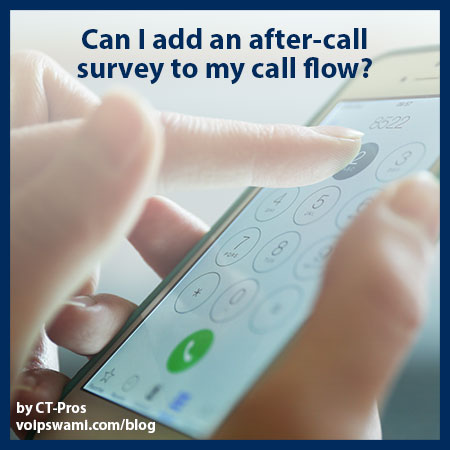
Swami Tech Talk Series
This post is provided by Ryan Cayton, Advanced Enterprise Solutions Engineer
We often get asked about after-call surveys and if a customer's current configuration can support such a thing.
I'm here to tell you, "Yes, let's make it happen" with the caveat that there are varying methods to do so based on how you would like your calls to flow to the survey and the costs involved.
I'm going to list them out in order of our recommendation and speak as to what is good and bad about each method.
Mitel Summit Using Direct Call
Using Mitel’s cloud-based IVR (interactive voice response) known as "Summit" with direct call-in numbers is the best and suggested method to do an after-call survey.
The caller would dial a number that is hosted in the Summit platform, be provided any initial IVR functionality desired, and then routed to the customer’s PBX.
The PBX call flow would proceed as normal and potentially be forwarded to an agent.
If the PBX or agent disconnects the call, Summit still has possession of the call and can continue on with IVR functionality including a post-call survey.
Survey results can be stored in our custom reporting platform called SwamiVision. These reports can also be emailed to you or even stored to your own web services via json/XML based APIs.
Pros to this solution:
- Best chance to get accurate data from the calls as there is no interaction from an agent to get the caller to the survey
- Reporting is excellent with this method as you get complete call information with the survey results by using our own SwamiVision product
- Allow recording of the audio message by the caller to be included in results
Cons to this solution:
- All calls must initially be answered by the Summit platform rather than answered locally by the PBX
- In relation to #1, the incoming calls are billed for the entire duration, resulting in increased monthly recurring charges
Mitel Summit Using Transferred Callers
In this scenario, the customer PBX would answer the call and progress through the normal call flow.
The agent could transfer the caller to an external number housed in the Summit cloud service or, in the event of a self-help IVR, a menu could provide the option to transfer the call.
Summit would take over the call and would provide a survey or other IVR functionality to the caller.
Pros to this solution:
- You pay only for the service you use rather than for the entire length of the call
- You get excellent reporting with SwamiVision
- Allow recording of audio message by the caller to be included in results
Cons to this solution:
- You must have the call transferred to the Summit application. This could open up the potential for agents to filter calls or for PBX issues to interfere with calls.
- Incomplete reporting as we cannot collect the entire call data points due to option 1 above. Survey results will be the only information collected.
- Use of extra trunk resources on the PBX side as there is an inbound call and then an outbound call, tying up two trunks for a single call.
Enhanced Contact Center
Lastly, you can utilize your existing ECC asset. The call would come into the PBX and contact center using normal call flows.
At the end of the transaction, the caller would be manually transferred to a new ECC IRN (inbound routing number) containing the survey or, if there is a self-service IVR, a menu option could be given to transfer to the survey.
They would flow through ECC IVR menus and the data would be written to IVR Applications for the built-in ECC reporting or potentially written to an external customer database.
Pros to this solution:
- One-time setup fee
- No external transfer to prevent usage of additional trunk resources
- Easily associate the call with Mitel Call Recorder and listen to the call post survey
Cons to this solution:
- Agents are required to transfer the call to the survey IVR manually. This opens up the potential for agents to filter less than excellent calls.
- The survey data is collected using either a customer database or pass through IVR application reporting via ECC reports.
- Undesirable data relationships as a result of how this information is collected in #2. You do not get a complete picture of the entire call.
Final Thoughts
As you can see, a lot needs to be considered when you decide to implement an after-call survey.
There are many ways to conquer this mountain and provide your team with valuable feedback on the customers they have interacted with.
After-call surveys increase your success and boosts your team's confidence by acquiring tangible satisfaction performance metrics that create morale boosters as well as great training opportunities.
If you're considering incorporating after-call surveys in your business or contact center operations, we can help get you started. Contact us today.